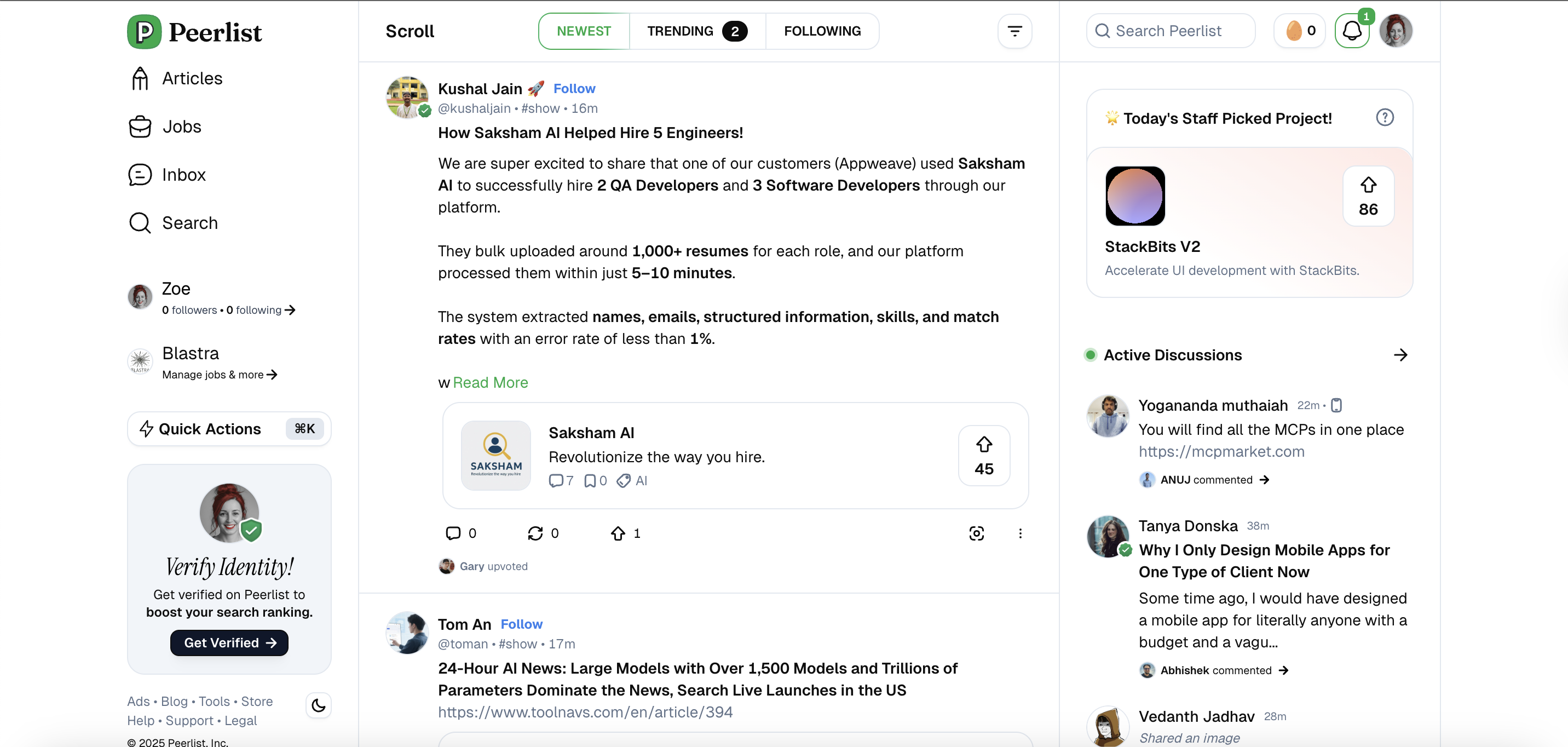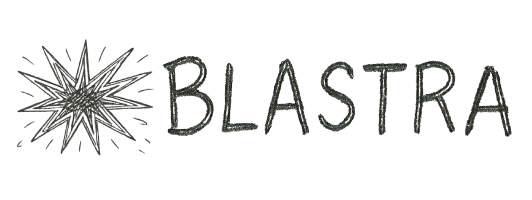You've probably seen Peerlist mentioned in startup circles but haven't quite figured out what it actually is. The platform keeps popping up in discussions about professional networking, product launches, and hiring, leaving many founders wondering if they should care about yet another social platform.
Peerlist sits somewhere between LinkedIn, Product Hunt, and GitHub, while being distinctly different from software directories like G2 or Capterra—which focus on product discovery and reviews (learn more about building competitive advantage through strategic directory presence). Founded in 2020 during the pandemic by married cofounders Yogini Bende and her husband as a side project, it combines elements of professional networking, project showcasing, and portfolio building for technical professionals.
The Problem It Solves
Cofounder Yogini Bende describes Peerlist as “a proof-of-work professional network for people in tech to showcase the work they're doing across the internet on a single page.” The frustration that led to its creation was surprisingly common among technical professionals.
As developer blogger Ashish Maurya explains the founder's experience: “She (Yogini) had to update her resume and share her work links. EVERY BLOODY TIME. Her work was distributed on different platforms, like Github and DEV. And her LinkedIn profile was useless to showcase her work.”
So It's Kind of Like LinkedIn for Tech People?
Not exactly. Many technical people have become frustrated with LinkedIn's evolution. Mahyar Mirrashed writes: “LinkedIn is a mess... it's devolved into a Facebook-like cesspool” while “Peerlist is the antidote” with “Clean, Modern UI” and a “Curated Community.”
While LinkedIn focuses on where you worked and what credentials you have, Peerlist aggregates your actual work from GitHub, Dribbble, Medium, Product Hunt, and other platforms into one unified profile. Instead of listing job titles, you're showing what you've actually built and created.
How It Actually Works
With around 100,000 users reached by early 2025, Peerlist remains small compared to LinkedIn's 1+ billion users or Product Hunt's millions of monthly users. However, considering LinkedIn launched in 2003 and Product Hunt in 2013, Peerlist's growth in just 5 years suggests meaningful traction within its target niche.
The user base has expanded beyond the initial developer focus to include “product managers writing case studies” and “Cofounders, CTOs, and investors” who “use Peerlist to add their portfolio companies, which is a use case we didn't expect,” according to Bende.
But here's where it gets interesting for startups: Peerlist also functions like a mini Product Hunt. Users post their projects daily, staff picks one for community voting and feedback. Unlike Product Hunt's broad tech audience, the voting and feedback come entirely from developers, designers, and technical product managers.
For startup founders building developer tools or technical products, this creates a more focused discovery mechanism. You're not trying to explain your API documentation tool to marketing professionals—you're showing it to people who actually use APIs.
 Peerlist profiles aggregate work from multiple platforms into one comprehensive portfolio for technical professionals
Peerlist profiles aggregate work from multiple platforms into one comprehensive portfolio for technical professionals
Beyond Individual Profiles
The platform evolved beyond individual profiles into something more comprehensive for startups. The job search aspect developed organically. Hiring manager Yashodhan Deshmukh shared his experience: “every single person who applied for this job was a designer... everything that I needed was in the Peerlist profile itself, dribbble feed+ link, Behance link medium posts and link, side projects, resume everything that was looking for was in the profile.”
Bende notes that “CTOs of many startups and many unicorns have reached out to us saying that people have started applying for jobs with their Peerlist profile” because “everything is right in front of the hiring people, making the initial call on whether to go ahead with the candidate or not has started becoming pretty easy for them.”
For startup founders, this creates a double opportunity: accessing pre-qualified technical talent and being discovered by quality candidates who understand what you're building. The platform's international community means you're not limited to local talent pools.
The Strategic Question
As Peerlist's own analysis notes: “In recent years, we all have experienced the shift from traditional degrees to more outcome-oriented work! Unless you can get the work done, your relevant degrees have much less importance than they used to be.”
So should your startup be there? It depends entirely on what kind of founder you are and what you're building.
The platform offers three main benefits for the right startups: establishing technical credibility within the developer community, accessing pre-qualified technical talent for hiring, and getting qualified feedback on technical products from people who actually understand them.
Unlike broader platforms like LinkedIn (general professional networking) or Product Hunt (wide consumer discovery), Peerlist focuses specifically on the technical community that evaluates quality work based on demonstrated output rather than marketing claims.
The Bottom Line
You should invest time in Peerlist if you're:
- A CTO or technical founder who actively builds and ships features
- Building products for developers or technical audiences
- Looking to hire technical talent from a pre-qualified pool
- Contributing to open source or writing technical content regularly
- Seeking technical partnerships or co-founder connections
Skip it if you're:
- Purely business-focused without technical output to showcase
- Looking for broad professional networking beyond the tech community
- Seeking traditional VC or business development connections
- Not consistently creating demonstrable work
The key differentiator is that Peerlist rewards actual work output over credentials. If your startup's success depends on building credibility within the technical community, accessing technical talent, or getting feedback from people who understand code, Peerlist offers a focused alternative to broader platforms.
For most B2B SaaS startups, especially those targeting developers or technical teams, establishing a presence makes strategic sense. The time investment is minimal compared to maintaining profiles across multiple platforms, and the concentrated technical audience means higher quality connections for your specific needs.
FAQ: Answers to Common Questions
Is Peerlist a replacement for LinkedIn?
No. Peerlist complements LinkedIn rather than replacing it. LinkedIn remains essential for broad professional networking, job searching, and connecting with business professionals across all industries. Peerlist serves a specific niche—technical professionals who want to showcase actual work output rather than job titles. Most users maintain both profiles.
How big is Peerlist compared to other platforms?
Peerlist reached about 100,000 users by early 2025—tiny compared to LinkedIn's 1+ billion users or Product Hunt's millions of monthly visitors. However, for a platform launched in 2020, this represents solid traction within its target niche. The smaller size means a more focused, engaged community rather than the noise of larger platforms.
Can I launch my product on Peerlist like Product Hunt?
Yes. Peerlist has a mini Product Hunt-style feature where users post projects daily for community voting and feedback. The key difference: feedback comes exclusively from developers, designers, and technical product managers. For developer tools or technical products, this focused audience can provide more relevant feedback than Product Hunt's broader tech audience.
What should I showcase on my Peerlist profile?
Focus on demonstrable work: GitHub projects, technical blog posts, design portfolios, side projects, open source contributions, and case studies. Peerlist aggregates content from platforms like GitHub, Dribbble, Medium, and Product Hunt into one unified view. The platform rewards "proof of work" over credentials—show what you've built, not where you've worked.
Is Peerlist worth the time for non-technical founders?
Probably not. Peerlist's value proposition centers on showcasing technical output. If you're not actively writing code, designing products, or contributing to technical projects, you'll have little to showcase. Non-technical founders are better served by LinkedIn for professional networking and traditional directories for product discovery.
You Might Also Like
- The Strategic Advantage of Directory Marketing: Why B2B SaaS Can't Afford to Ignore It - Learn how directory presence creates a competitive moat for your B2B SaaS
- How to Get Your Software Ranked on G2 (and Why Invest in It at All) - Master G2's scoring algorithm and earn those coveted badges
- G2 & Capterra Review Guidelines: The Complete Playbook for B2B SaaS - Everything you need to know about managing reviews on G2 and Capterra
Use Blastra to submit your business to relevant software directories and manage your listings.

